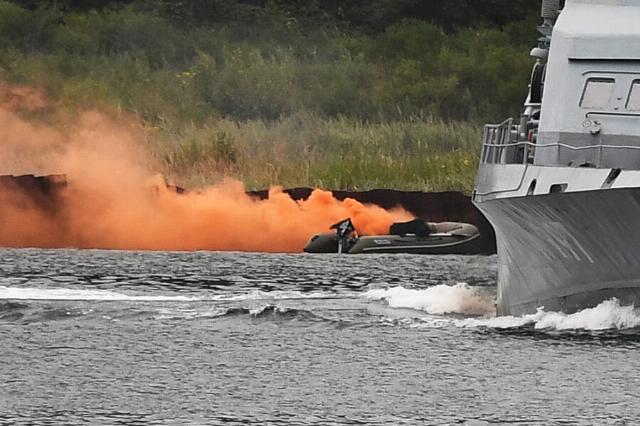The Ministry of Defense showed a video of the destruction of the Ukrainian Navy ship Simferopol at the mouth of the Danube.
The Russian Defense Ministry announced the destruction of the Simferopol reconnaissance vessel of the Ukrainian naval forces in the Danube Delta. The target was hit with the help of a crewless boat, which was the first successful use of backups by the Russian military. According to Kiev, one soldier was killed, and several others were missing. This strike was not the first attempt to destroy one of the newest ships of the Ukrainian Navy, but earlier it was damaged and was able to leave for Odessa.
A Russian unmanned boat sank the Ukrainian ship Simferopol in the mouth of the Danube, the Russian Defense Ministry said.
According to the Russian military, the Ukrainian Armed Forces ship sank.
According to Kommersant, attempts to destroy this ship have been made before: in December 2024, Russian troops attacked it with the Iskander missile system, but the Simferopol, having been damaged, was able to escape under its own power to its home port of Odessa.
Kiev's reaction
The speaker of the Naval Forces of Ukraine, Dmitry Pletenchuk, confirmed the fact of the strike on the ship, and also reported one dead Ukrainian serviceman and several missing.
"Regarding the information about the defeat of one of the ships of the Ukrainian Navy, we confirm the fact of a strike on the ship, and the elimination of the consequences of the attack is currently underway. The vast majority of the crew is safe," Pletenchuk said.
According to him, the search for several sailors is currently underway. One crew member was killed.
According to Kommersant, the Simferopol was laid down at the Leninskaya Kuznitsa shipyard in Kiev as a civilian fishing trawler of the 502EM project.
In 2017, it became known that an average reconnaissance ship would be built on the basis of this hull for the Ukrainian Navy. Launched in 2019, sea trials began in January 2020.
Displacement - 1220 tons. The crew consists of 29 people, and the navigation period is 28 days.
It was equipped with reconnaissance radio equipment (including the Melchior radio reconnaissance station and Rohde &Schwarz broadband direction finder antennas), a 30 mm artillery installation and MANPADS.
It was intended for conducting electronic intelligence and collecting data on the actions of the Russian military in the waters of the Black and Azov Seas.
"The first confirmed case"
Denis Fedutinov, an expert in the field of unmanned aircraft, confirmed that for the first time a Russian unmanned boat was able to sink a ship of the Ukrainian Navy.
"This is the first case confirmed by the Ministry of Defense of the Russian Federation of the destruction of a Ukrainian Navy ship by a Russian unmanned boat. Of the resonant episodes of the use of Russian backups, I recall only the episode with the explosion in the area of one of the bridges over the Dnieper River," he said in an interview with TASS.
Fedutinov expressed the hope that the Russian military will continue to actively use unmanned boats, because this is "one of the promising areas for the development of asymmetric weapons and military equipment."
According to military observer Viktor Litovkin, unmanned naval drones are very popular with the Ukrainian Armed Forces and have been in service with them for a long time. In particular, Kiev often sent its unmanned boats to Sevastopol, Kerch and the Crimean Bridge. Russian troops have learned how to intercept such boats, and now they themselves have begun to use their analogues.
- said the military observer in an interview with the newspaper.Ru" .
Such unmanned boats can attack not only ships and vessels that are at sea, but also ports and any objects on the coastline.
Advantages of backups
According to the Military Chronicle, Russian forces decided to attack the Ukrainian ship at the mouth of the Danube not with missiles, but with the help of backups due to a number of their features.
Firstly, unmanned boats "solve the problem precisely and are ten times cheaper" than supersonic anti-ship missiles. Secondly, the tanks are able to enter the water area "actually as a sabotage group" and hit the target in close combat, and the Danube Delta with its relief and shallow water is poorly suited for missile strikes.
"On Ukrainian territory, the Danube Delta is located in the Odessa region. Here the river divides into several branches, the largest of which is the Kilian girlo. It is along it that the border between Ukraine and Romania runs, and it is considered the fastest part of the delta. If the backups went there and destroyed the target, then this is definitely a success for the Russian Federation," the newspaper notes.
Thirdly, the Russian Armed Forces wanted to work out the use of marine drones, and the situation turned out to be suitable.
For the first time, the Russian military used domestic backups during the July Storm exercises in the Baltic Fleet, hitting a simulated enemy ship with them. At that time, kamikaze vehicles with a large warhead, optical systems and a direct control channel were used.
Leonid Tsvetaev

